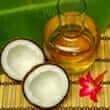Background
- Caprylic acid is an eight-carbon fatty acid naturally found in palm and coconut oil, and in the milk of humans and bovines (cows). Caprylic acid is classified as a medium-chain fatty acid and chemically known as octanoic acid. The U.S. Food and Drug Administration (FDA) has approved caprylic acid with generally recognizable as safe (GRAS) status. It is used as parenteral nutrition in patients who require nutrition supplementation, as well as in some drugs, foods, and cosmetics.
- Nutritionists often recommend caprylic acid for use in treating candidiasis (yeast infection) and bacterial infections. However, there is insufficient clinical data available to support the used of caprylic acid for any claimed therapeutic uses.
References
- Giannakou SA, Dallas PP, Rekkas DM, et al. In vitro evaluation of nimodipine permeation through human epidermis using response surface methodology. Int J Pharm 7-8-2002;241(1):27-34.
View Abstract - Han J, Hamilton JA, Kirkland JL, et al. Medium-chain oil reduces fat mass and down-regulates expression of adipogenic genes in rats. Obes Res 2003;11(6):734-744.
View Abstract - Hoshimoto A, Suzuki Y, Katsuno T, et al. Caprylic acid and medium-chain triglycerides inhibit IL-8 gene transcription in Caco-2 cells: comparison with the potent histone deacetylase inhibitor trichostatin A. Br J Pharmacol 2002;136(2):280-286.
View Abstract - Kalantar-Zadeh K, Braglia A, Chow J, et al. An anti-inflammatory and antioxidant nutritional supplement for hypoalbuminemic hemodialysis patients: a pilot/feasibility study. J Ren Nutr 2005;15(3):318-331.
View Abstract - Lima TM, Kanunfre CC, Pompeia C, et al. Ranking the toxicity of fatty acids on Jurkat and Raji cells by flow cytometric analysis. Toxicol In Vitro 2002;16(6):741-747.
View Abstract - McLay JC, Kennedy MJ, Orourke AL, et al. Inhibition of bacterial foodborne pathogens by the lactoperoxidase system in combination with monolaurin. Int J Food Microbiol. 2-25-2002;73(1):1-9.
View Abstract - Nagata J, Kasai M, Negishi S, et al. Effects of structured lipids containing eicosapentaenoic or docosahexaenoic acid and caprylic acid on serum and liver lipid profiles in rats. Biofactors 2004;22(1-4):157-160.
View Abstract - Nair MK, Joy J, Venkitanarayanan KS. Inactivation of Enterobacter sakazakii in reconstituted infant formula by monocaprylin. J Food Prot. 2004;67(12):2815-2819.
View Abstract - Olsen H, Andersen A, Nordbo A, et al. Pharmaceutical-grade albumin: impaired drug-binding capacity in vitro. BMC.Clin Pharmacol 3-29-2004;4:4.
View Abstract - Robertson MD, Jackson KG, Fielding BA, et al. Acute ingestion of a meal rich in n-3 polyunsaturated fatty acids results in rapid gastric emptying in humans. Am J Clin Nutr 2002;76(1):232-238.
View Abstract - Robinson MK. Population differences in acute skin irritation responses. Race, sex, age, sensitive skin and repeat subject comparisons. Contact Dermatitis 2002;46(2):86-93.
View Abstract - Samsom M, Vermeijden JR, Smout AJ, et al. Prevalence of delayed gastric emptying in diabetic patients and relationship to dyspeptic symptoms: a prospective study in unselected diabetic patients. Diabetes Care 2003;26(11):3116-3122.
View Abstract - Schneider AR, Kraut C, Lindenthal B, et al. Total body metabolism of 13C-octanoic acid is preserved in patients with non-alcoholic steatohepatitis, but differs between women and men. Eur J Gastroenterol Hepatol 2005;17(11):1181-1184.
View Abstract - Sogorb MA, Carrera V, Vilanova E. Hydrolysis of carbaryl by human serum albumin. Arch Toxicol. 2004;78(11):629-634.
View Abstract - Wanten GJ, Janssen FP, Naber AH. Saturated triglycerides and fatty acids activate neutrophils depending on carbon chain-length. Eur J Clin Invest 2002;32(4):285-289.
View Abstract







